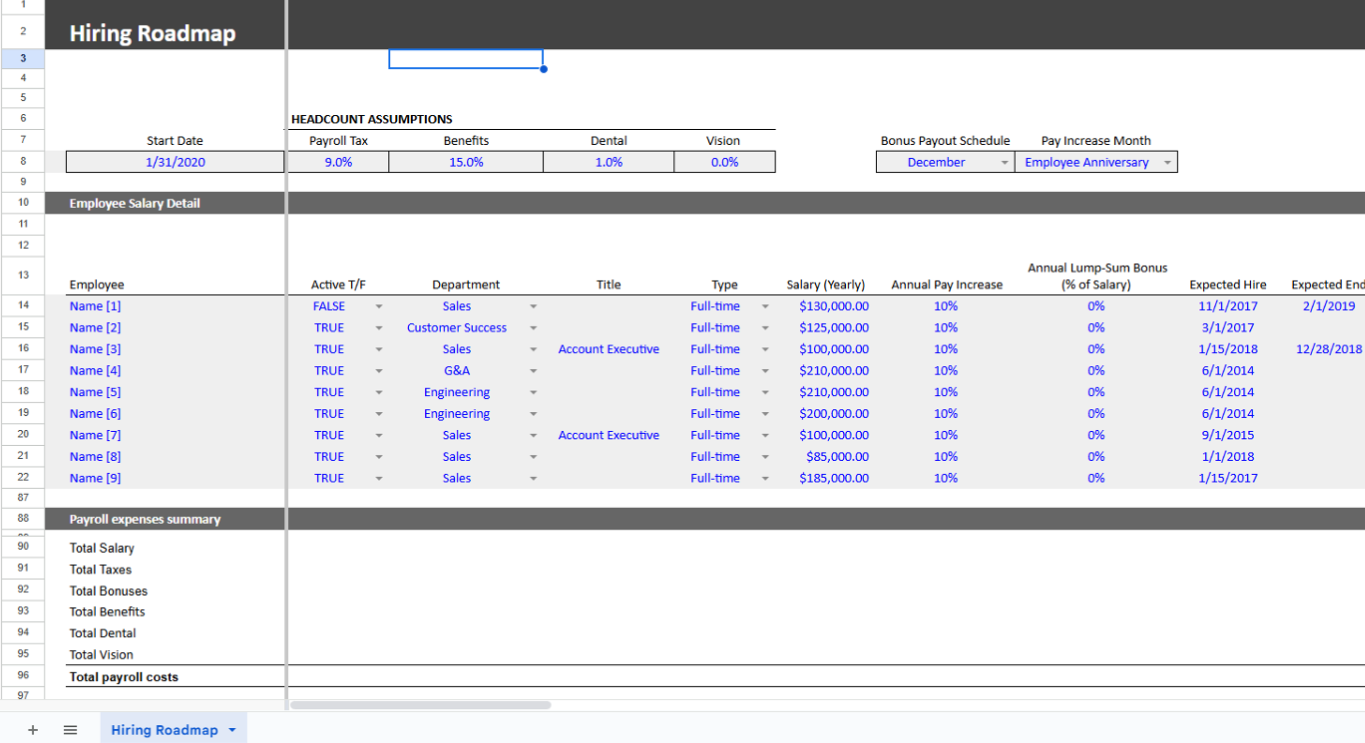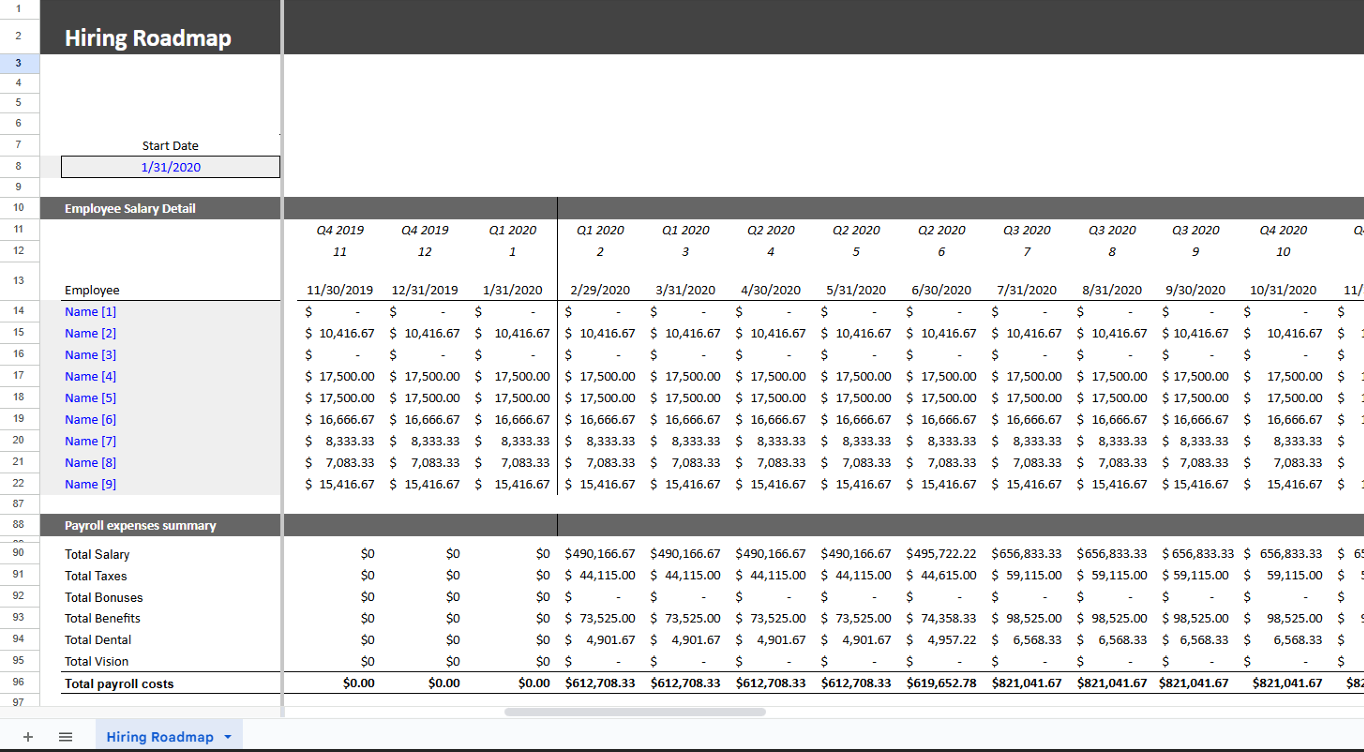The Headcount Planning Module: A Simple Tool to Control Your Burn Before It Controls You (+ Excel Template)
The Excel template used by top founders and VCs to track every hire, salary, and fully-loaded cost
Not many realize how many startups were destroyed through bad hiring. One ambitious headcount sprint done without understanding the real cost structure can shred months off your runway.
Most founders build their team plan in Notion or Google Sheets, track base salaries, and call it a day. But what they miss is what really drains the bank: payroll tax, benefits, annual raises, bonuses, and hidden costs that creep in.
That’s why we built a headcount planning module, a one-sheet excel template designed to bring total clarity to every hiring decision. It surfaces the full cost of each role, maps timelines automatically, and helps founders, finance, and HR to finally align around reality.
In this article, we’ll show you why headcount is the biggest blind spot in startup operations, and how this headcount planning template helps you take back control before burn takes you by surprise.

Table of Contents
1. Why Every Startup Needs a Headcount Planning Model
2. What is the Headcount Planning Module And What’s Inside
3. How to Use the Template (3-Step Workflow)
4. Who Should Use It and When
5. Download the Excel Template
6. Frequently Asked Questions
1. Why Every Startup Needs a Headcount Planning Model
The biggest cost in your startup isn’t your tools, rent, or marketing stack. In reality, it’s people. Headcount accounts for 60-80% of early-stage burn, making it your most powerful lever for financial control.
Yet most startups treat it like an HR admin task. That’s a mistake.
Burn Starts with Hiring
Every new hire commits you to months, if not years, of cash outlay. But when your hiring plan lives in Notion and your runway model lives in a chaotic Excel file, decisions get made in silos.
Finance signs off on raises without knowing what HR has already queued. Founders approve headcount in investor calls without seeing the downstream impact. The unfortunate result is that the runway dies in spreadsheets.

VCs Notice the Disconnect
It’s no longer enough to say “we’re hiring 10 engineers.” Investors want to see how those roles map to runway, how timing affects burn, and whether you’re modeling taxes, benefits, and real compensation load. Without that, you’re just guessing, and VCs do not back guesses.
This Isn’t Optional
Headcount planning brings order to chaos. It forces a conversation between strategy, finance, and execution. If you’re not modeling headcount at a granular level, you’re not in control of your burn.
And if you’re not in control of your burn, you’re not in control of your startup.
2. What is the Headcount Planning Module And What’s Inside
The headcount planning module is a one-sheet excel template built to show you, clearly and immediately, how your hiring plan impacts cash flow, burn, and runway. It’s not a static hiring tracker or a Google Sheet wishlist.
It’s a living roadmap that maps every hire, salary, tax, and benefit over time; down to the dollar, month by month.
Let’s break it down.
A Dynamic Dashboard, Not a Clunky Table
At first glance, it looks like a simple spreadsheet. But under the hood, it's structured more like a financial control tower. The top row lets you define global assumptions such as payroll tax %, benefits load, dental, vision, and even when bonuses are paid out (e.g. December vs anniversary month). These assumptions auto-populate every cost formula in the sheet.
Beneath that is the Employee Salary Detail, a clean, role-by-role table where you list each hire (or planned hire) alongside their department, role, employment type (FTE vs contractor), and key compensation variables: base salary, raise %, bonus %. An “Active T/F” switch controls whether the role shows up in calculations, letting you toggle scenarios without deleting data.

The Magic Happens in the Timeline
Scroll right, and the automated monthly timeline kicks in where 60+ columns are designed to track each role’s monthly salary, payroll tax, bonus, and benefit. This dynamic range adjusts for every role’s unique start and end dates.
Need to see what your total burn looks like in Q2 2025? It’s there, broken down into exact figures for salary, tax, and benefits.
These columns dynamically calculate based on:
Start and end dates (partial months are prorated)
Raises over time
Bonus logic (e.g. annual bonus paid in Dec 2025)
Global assumptions up top
No manual inputs. No broken formulas. It’s all connected.
Summary Metrics You Can Actually Use
At the bottom, the payroll expense summary auto-rolls totals for salary, taxes, bonuses, benefits, dental, and vision, plus the grand total: your real payroll cost. You’ll also see live KPIs like:
Total Headcount (filtered by Active toggle)
Department-wise Headcount
Average Fully-Loaded Comp per Employee
Payroll Tax Load per Hire
Total Monthly Burn from people costs alone
This is what makes the headcount planning module different. It's more than a simple tracker. It’s a fully-loaded financial instrument that founders, finance, and HR can all use, together, to make better hiring decisions, model headcount scenarios, and protect runway before it disappears.

These numbers give you the lens to ask: Are we hiring efficiently? Are we structuring comp in line with our burn targets? Are we prepared for the next fundraise with clean metrics?
Don’t think of this model as a simple tracker. Think of it as a decision engine. It helps you model growth, spot bloat, and stay ahead of your burn, not running behind it.
3. How to Use the Template (3-Step Workflow)
You don’t need to be a spreadsheet wizard to use this. The headcount planning module is designed so founders, operators, and HR leads can get started in 10 minutes or less. No formulas to touch. No hidden tabs. Just plug, view, and decide.
Here’s how to use the excel template in three simple steps:
1. Drop Your Data
Start by updating the Global Assumptions at the top:
Payroll tax %, benefits %, bonus %, and model start date
Bonus timing (calendar year vs anniversary-based)
Any add-ons like dental or vision coverage
Then go to the Employee Table and enter your team:
Names (or role placeholders if not yet hired)
Department, start date, and end date if applicable
Base salary, raise %, bonus %
Set each row as FTE or Contractor
Use the Active T/F switch to toggle on/off scenarios without deleting anything
This is where your plan comes to life.
2. Review Auto-Metrics
Scroll right into the Automated Timeline. You’ll instantly see:
Salary plotted by month for each role
When raises hit and how they compound
How taxes, bonuses, and benefits change over time
Collapse columns if you want to see quarterly or annual aggregates. The math is already done, you're just reading the story.
3. Make Decisions or Share
Now the real power kicks in:
Delay a hire’s start date to shave $80K off next quarter’s burn
Adjust salary or bonus assumptions to align with board expectations
Quickly generate headcount scenarios by toggling rows or changing assumptions
When you're ready, copy the Summary Rows at the bottom into:
Board decks
Fundraising models
Departmental budget reviews
Or your master runway tracker
No exporting. No rework. The headcount planning template keeps everyone on the same page, and lets you move from guessing to precision.

4. Who Should Use It and When
The headcount planning module wasn’t built for finance PhDs or FP&A specialists. It was built for operators, people making real decisions in real time, who need clarity more than complexity.
Ideal Users
If you’re in any of these roles, this excel template will instantly upgrade how you plan, communicate, and execute:
Founders who need to map out hiring across the next two to three quarters, especially when cash is tight or runway is unclear.
Finance Leads / FP&A professionals modeling multiple headcount scenarios before running a fundraising process or budget reset.
HR and People Ops leaders who want to sanity-check offers before they send them, or prove to leadership that certain hires aren’t yet budgeted.
Department Heads preparing for annual planning or pitching for budget in a board meeting.
Ultimately, you don’t even need excel experience to use this model. You just need a team to grow, a burn rate to manage, and decisions to get right.
Ideal Stage
This tool is built for Seed to Series B companies. It’s especially useful during:
Pre-raise financial planning (so you know how long the money will actually last)
Post-raise resource deployment (so you spend wisely, not blindly)
Annual planning season (when every team wants more headcount)
Unexpected shifts like revenue shortfalls, hiring freezes, or pivot plans
If you don’t want to be paying $50K per year for an FP&A tool, this will get you 80% of the way there, with fewer clicks and better focus.
As a premium subscriber (free trial available), you will also get access to the full library of resources (+50)
5. Download the Excel Template Below 👇
Keep reading with a 7-day free trial
Subscribe to The VC Corner to keep reading this post and get 7 days of free access to the full post archives.

